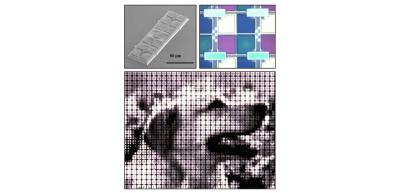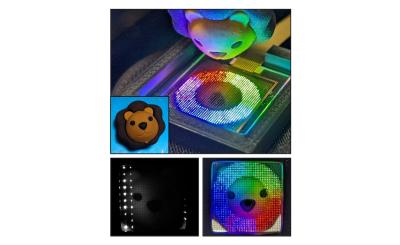Justin Brown is X Display's Executive Vice President for Operations & Equipment. Justin leads the company’s supply chain development, manufacturing partner relationships and also its Equipment division, which provides mass-transfer equipment for XDC’s partners and licensees. Justin was kind enough to answer a few questions we had for XDC.
Q: Hello Justin, thanks for your time. XDC has been a bit quiet in the last few years. Can you bring us up to date on your microLED technologies, processes and products?
Thank you for the opportunity to share the progress at XDC. We have been busier in the near past than ever before. As you know, we first announced our MicroIC technology, our mass transfer process, our manufacturing equipment and the uniqueness of our approach, the IP strength we possess and the experience of the team. This led to broad customer visibility and we narrowed down our efforts to a select set of partners that we are currently working with. We have deep engagements with customers that we anticipate will result in end product announcements in the future.
As to our technology and product progress, we first developed our MicroIC products for an OLED customer some 15 years ago; since then we have developed the technology much further: today, we are bringing the display drivers onto the same plane as the emitters.
We continue to develop our mass transfer technology. The better we can do the transfer, the lower the cost for our customers; we are transferring 200 million units per hour with a quarter micron placement accuracy. We have shipped >30+ of our Micro Transfer Printing (MTP) equipment to customers, here is a list of the four product types and configurations we ship.
microIC driven White AMOLED without TFT, 2008
Q: We understand that you have recently produced several new display prototypes, including a transparent display. Can you share these latest prototypes and their specifications?
Recently we held private showings of microLED displays that were 70% transparent and very bright, more than 2000 cd/m2. We also showed displays that use microIC drive schemes that scale to hundreds of PPI and best-in-class power efficiency.
1:16 microIC:Pixel drive for battery applications
Q: Can you share more information about your microtransfer technology and equipment, in its current generation
Our technology is based on pioneering work and discoveries from Prof. John Rogers’ group; our technology uses PDMS stamps that are conformable, offers reversive adhesion, transparent, low cost and mechanically robust. We are transferring chips as small as 3microns, the smaller the chip size the more we can fit in a wafer, reducing overall device cost. For stamps, we use tiny ones the size of 1mm square up to 200mm square; the larger stamps allow us to transfer millions of units at a time, thereby reducing process time/cost and improve capital equipment efficiency.
We have developed the supporting equipment to exercise these stamps. We are on our 4th generation of micro-transfer printing platform and have over 30 tools installed at customer sites around the world.
Q: We know that XDC has shipped its mass transfer equipment to several companies, including to Lextar, UPVFab and Daktronics. Can you tell us more about these units? Are these R&D tools? How close are you to actual industrial production equipment shipment?
We have four product families and they range from R&D tools to 200mm and 300mm production tools and also a G4.5 panel tool. We have shipped both R&D and production ready tools to customers and announced a few that weren’t confidential. Our industrial customers are using the tools to make prototype and pilot level production of samples of various types. Some are focused on small format display applications whereas some are building large area signage products. Our university and research collaboration customers are using the R&D tools to test various materials, configurations and product types.
Our 4th Generation platforms MTP-200/300/G4.5Panel equipment are designed for a 10-30 secs cycle time to pick, print and clean. It provides ample capability for our customers to prove out their materials, processes and design products.
Q: XDC is working on an eco-system for the production of consumer microLED displays. We'll be happy to learn more, and whether you see the collaboration between several companies as a key requirement towards building a microLED fab?
We do indeed. Our eco-system ranges from LED suppliers to panel makers to semiconductor companies to end device designers and contract assemblers to OEMs that are driving the final product outcomes. MicroLED is emerging as a better alternative to conventional displays but its not mature enough for a single company to have all of the pieces together to manufacture a final product. We realized that collaboration is the fastest way to developing a product and mitigating risks at different stages of production. We work closely with our eco-system partners to advance the technology, we are in active engagements to develop and launch a product with some of the biggest companies in the industry.
Q: XDC is focusing on microIC based displays. We'll be happy to hear more, especially about the economical and scalability of such a platform.
We were making MicroIC drivers for OLED displays long before MicroLED became a serious topic in the industry. Our MicroICs are single crystal NMOS, PMOS or CMOS type, they have high mobility, can have really fine features thereby allowing for tight integration into what we call Pixel Engines that comprise of R, G and B LEDs and a MicroIC. This package affords very high stability, low leakage, low power, high speed and superb performance.
In some designs, we can use a single MicroIC to drive upto 16 pixels, we do this by sharing analog functions of the IC with a cluster of pixels; this approach allows us to achieve memory in pixel effect, lower the silicon footprint that is desirable in transparent displays, efficiency is increased and costs are lower.
Our newest work includes integrating sensing elements like touch, gesture and other advanced sensing into the display leveraging our MicroIC’s capabilities. We recently published a paper explaining some of our work. We believe that we could make a smart display with integrated capabilities that is lower cost and higher performance using these techniques.
Senseplay – IR camera under display
Q: Do you think microLED technology is ready to tackle the mass display markets (consumer TVs, IT, wearables and smartphones)?
Not quite yet – all new technologies in their various forms are ideally suited for a narrow set of applications as its initial foray. Offering unique advantages in terms of brightness, form factors, lifetime, cost etc will enable some early applications to succeed. Following that the technology will expand into adjoining ponds.
At XDC, we aren’t focused on TV, are also not focused on emerging consumer electronics products, each of these have additional challenges that our current area of focus does not have. We are working to enable mass production of MicroLED and OLED displays using our MicroIC technology, into industrial and consumer applications that are already proven and well established. By offering unique and differentiated features and performance benefits, our eco-system expects to displace the incumbent traditional displays. We expect to make product announcements in the near future, together with our customers and partners.
Q: Which applications do you feel are most promising for microLEDs in the near future?
There is segment of the industry that is working on wearables that desire high brightness that MicroLEDs offer; there are also large consumer electronics companies like Sony and panel makers like Samsung, LG and others that have launched TV’s with smaller and smaller LEDs, approaching MicroLED sizes. We see these already into the market but adoption is low due to cost. Our industry has a history of driving down these costs and adopting unique technologies like our MicroIC and Pixel EnginesTM components to solve some of the challenges of manufacturing, cost and performance. We also see opportunities in tablets, phones and laptops.
Q: When Apple cancelled its microLED wearable projects, many in the industry saw their confidence reduced. How do you feel about Apple's decision? Will it impact the industry in the long term?
Apple currently does not make displays for any of its products, these are made by the biggest and best companies in the industry, we expect that they will do the same with MicroLED or any other display technology. We are pioneers in this area and had been developing IP long before others in the industry, we have a strong belief in the technology as a superior alternative to what exists today and we have an even stronger belief in our company’s ability to deliver. We have a strong team comprised of the most experienced in the industry and our eco-system partners are hugely successful companies that have launched successful products using new technologies like ours.
Thank you for your time and information Justin. We hope to hear some good news from X Display soon!





